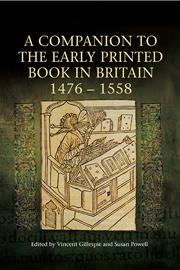Book contents
- Frontmatter
- Contents
- List of Illustrations
- List of Contributors
- Preface
- Acknowledgements
- Abbreviations
- Chronology of the Period
- Introduction
- I THE PRINTED BOOK TRADE
- II THE PRINTED BOOK AS ARTEFACT
- III PATRONS, PURCHASERS AND PRODUCTS
- IV THE CULTURAL CAPITAL OF PRINT
- 12 Humanism and Printing
- 13 Women Translators and the Early Printed Book
- 14 The Printed Book Trade in Response to Luther: English Books Printed Abroad
- 15 Thomas More, Print and the Idea of Censorship
- 16 Catholicism, the Printed Book and the Marian Restoration
- Index of Manuscripts
- Index of Printed Books
- General Index
16 - Catholicism, the Printed Book and the Marian Restoration
from IV - THE CULTURAL CAPITAL OF PRINT
Published online by Cambridge University Press: 05 April 2014
- Frontmatter
- Contents
- List of Illustrations
- List of Contributors
- Preface
- Acknowledgements
- Abbreviations
- Chronology of the Period
- Introduction
- I THE PRINTED BOOK TRADE
- II THE PRINTED BOOK AS ARTEFACT
- III PATRONS, PURCHASERS AND PRODUCTS
- IV THE CULTURAL CAPITAL OF PRINT
- 12 Humanism and Printing
- 13 Women Translators and the Early Printed Book
- 14 The Printed Book Trade in Response to Luther: English Books Printed Abroad
- 15 Thomas More, Print and the Idea of Censorship
- 16 Catholicism, the Printed Book and the Marian Restoration
- Index of Manuscripts
- Index of Printed Books
- General Index
Summary
‘Preachers, players and printers… be set up of God, as a triple bulwark against the triple crown of the pope, to bring him down.’ John Foxe was quite sure that the invention of printing was a providential gift by which God hastened the advance of the true church. The link between printing and Protestantism has long been established in the historical imagination. Indeed, the arrival of printing has been seen as the first step in an even greater cultural transformation that incorporated Renaissance, Reformation, Scientific Revolution and Enlightenment. Despite the subtleties of most historical writing on the subject, there is still a tendency towards easy contrasts: medieval against early modern, manuscript against print, Catholic obscurantism against Protestant communication. This has dovetailed with the still-lingering popular narrative which portrays the pre-Reformation church as superstitious, corrupt and unpopular and contrasts it with a Protestant movement which was reformed, biblical, popular and progressive. The still pervasive conclusion is that the printing press was the foundation of Protestantism, because Protestantism was the religion of the book.
This network of assumptions is deeply misleading. There were of course points at which the nexus between print and Protestantism was particularly influential, such as in the German states in the 1520s, or with Foxe's own magisterial work, the Acts and Monuments, in Elizabethan England. The overall picture, however, is very different.
- Type
- Chapter
- Information
- A Companion to the Early Printed Book in Britain, 1476-1558 , pp. 307 - 324Publisher: Boydell & BrewerPrint publication year: 2014

